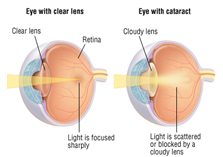What is Cataract?
Cataract refers to opacification of the normal clear crystalline lens in the eye.The lens of the eye acts like the lens in a camera. It focuses much of the light coming through the eye on
to the retina. The lens must be clear for the retina to receive a sharp image. As the lens becomes cloudy, the light entering the eye is scattered or blocked leading to blurred or cloudy vision. Cataract develops gradually
and is most commonly seen in elderly people.
What are the causes of cataract? The most common cause of cataract is age. Other causes include diabetes, injury, chronic use of steroids, and secondary to other eye diseases such as uveitis.Cataracts can occur
early in diabetes, high myopia (short sightedness) and as a hereditary predisposition.
What are the symptoms of cataract?
Gradual blurring of vision
Frequent change in glass numbers
Glare
Faded colors
Haloes around light
Double vision
Is there any other treatment for cataract besides surgery?
There are no medications, eye drops, exercises or glasses that will cause cataract to disappear or prevent it from growing. Surgery is the only way
to remove a cataract.
When should cataract surgery be done?
Cataract surgery should usually be considered when cataract begins to affect quality of life or interfere with ability to perform normal daily activities.
How is cataract surgery performed?
Cataract surgery is usually performed under topical anaesthesia(anaesthetic eye drops only, no injection). Surgery involves removing the opacified lens and replacing it
with an artificial clear intraocular lens.Recent advances in cataract surgery have reduced the size of incisions made during cataract surgery, making it safer. Phacoemulsification is at present universally accepted as the standard
of care for cataract surgery. Ultrasound energy is used in phacoemulsification to break up the cataract (emulsify) into microscopic fragments which can be sucked out of the eye.MICS (Micro incisional Cataract surgery) is the
latest technique for cataract removal and has been demonstrated to be minimally traumatic surgery, providing better postoperative outcome than traditional phacoemulsification.MICS is phacoemulsification of the cataract through
a wound of 2.2 mm or less, with implantation of an intra-ocular lens through the same wound, thus making it a sutureless surgery.
What is the recovery time after cataract surgery?
Due to the recent advances in cataract surgery, recovery time is very quick. Vision is usually improved the day after cataract surgery. Patient can usually
resume back almost all activities after 1 week of cataract surgery.
At Kumta Eye & Retina Clinic, cataract surgery is performed exclusively with the latest phacoemulsification technology using OZIL technology of the Constellation. Every surgery is performed with no injection, no stitch, no pad & 100% painless technique lasting about 13 -15 mins. Intraocular lens power is measured on A-scan biometry as well as the latest optical biometry (LENSTAR) for very accurate measurements. Premium IOLs of the best companies including the Aspheric, Toric & Multifocal lenses are used.





